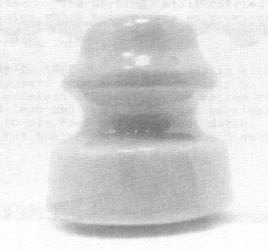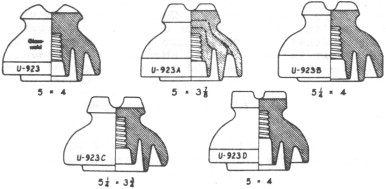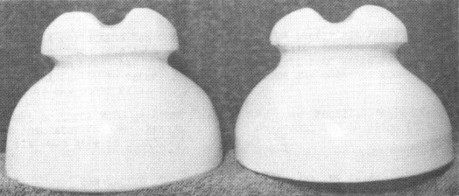Porcelain Insulator News
by Elton Gish, NIA #41
Reprinted from "Crown Jewels of the Wire", November 1987, page 13
There was a very unusual porcelain insulator at the 1986 National show in
Saratoga Springs, New York that I have let slip by without being reported. It
was proudly displayed by Larry Emmonds as part of his fantastic Model A Ford
truck display. The insulator is pictured below -- and it is sim U-292 with THOMAS
prominently incused on the top of the crown. You are probably saying "What
is so special about that?". Well, the reason the photo lacks good contrast
against a white background (I hope that the weak image shows up after printing)
is not that it has a white glaze, but because the glaze is a beautiful light
peach PINK. Yes, I said P-I-N-K.

Larry acquired a huge collection of porcelain from a lineman and this piece
was covered with dark grime from years of heavy service. You have got to see this rare jewel to believe
the color. There is no doubt after close examination that it is genuine and is
the only insulator known with this glaze color.

The next insulator is pictured below on the left with an Imperial U-923 on
the right for comparison. This is a new style of Imperial and Jack has assigned
it U-923E. The other five cross-top styles are shown for comparison. The U-923E has a white glaze and bears the typical incuse Imperial style date of
manufacture stamp with the date 5-16-03. No other markings were used. The 1903
date is late for Imperial in their manufacture of pin types. The latest date
known on an Imperial pin type is 3-17-04. They may have made pin types until a
fire destroyed their plant in 2-03-1907. However, with few specimens extant from
this period and the prominence of other porcelain manufacturers such as Locke,
Thomas, New Lexington and Lima, I doubt that Imperial was able to successfully
compete. Imperial was primarily a specialty porcelain manufacturer until they
went out of business sometime soon after 1936.


The cross-top originated as a design by Fred Locke in 1895. He had units made
for him by Electrical Porcelain & Manufacturing Co., Imperial Porcelain Works
and maybe Peru Electric Manufacturing Co. in the 1895 to July 1, 1897 period.
The first style was the dry process style U-923C which was probably made by Electrical Porcelain & Mfg. Co. and introduced by Locke in 1895. The only
marking used was an embossed (raised) Fred Locke two date marking #2-1 in the
top cross grooves (see Jack Tod's second edition book Porcelain Insulators Guide
Book for Collectors for a detailed list of Fred Locke markings. Also produced
about this time was U-923B which was also a dry process unit probably made by
another company but again not an Imperial item. I have never seen a U-923B and
the U-923C is very scarce.
The first cross-top style manufactured by Imperial was U-923A. It was similar
to the dry process styles of U-923B and U-923C (similar crown design) but it was
made by the superior wet process. The dry process units were too porous to
provide sufficient insulation during wet conditions for the higher voltages of
the new lines. The U-923A was made in 1896 until late in the year. The units are
incuse marked in the cross-top grooves with Fred Locke's two date marking #2-2
and on the lower skirt "Manufactured by Imperial Porcelain Works". The
U-923A is fairly common.
Beginning in late 1896 until July 1, 1897, Imperial made style U-923. These
units are never marked in the cross-top grooves but bear an incuse wordy
Imperial marking on the skirt which states 'Manufactured for F. M. Locke Victor,
N. Y. of Imperial Porcelain followed by three of Fred Locke's patent dates. Now
this was a bold step by Imperial to proclaim more of their share of the
recognition for their fine workmanship and to minimize the exposure of Fred's
name and patent dates. The marking still carried the two Locke patent dates
which before was so prominent in the cross-top grooves and, by the way, had
nothing what so ever to do with the insulator.
After July 1, 1897 (officially July 15 although the new marking appears on
specimens as early as July 7), all Imperial porcelain insulators were marked
with their familiar crown logo and wordy Imperial markings without any reference
to ole Fred or his patent dates. Imperial started to market their own insulators
and snubbed Fred by not marking units made for him with his name and patent dates. This surely
was a major force to convince Fred to enter into manufacturing his own porcelain
insulators.
Finally, U-923D was manufactured by Fred Locke. Only one specimen is known to
exist and it bears Locke's six patent date marking #6-l on the skirt without
markings in the cross-top grooves. This style is patterned after the original
crown design and was probably produced in 1901.
There are two new porcelain styles that need to be reported. One is an
exchange that Jack has assigned U-74. The unit is unmarked.

The second is a little more exiting. It has been assigned U-927D. As you can
see from the drawing, it is a glazeweld. The glaze color is a pretty mottled and
speckled reddish pumpkin, different than the Lapp pumpkin glaze. It has a 1-3/8"
unglazed pinhole as you might expect from Pittsburg. The unit is unmarked and is
illustrated in Pittsburg's catalogue No. 3 (year unknown). Two other glazeweld
styles are shown in the catalogue: U-933 and U-964A. Do any of you have these
three Pittsburg styles?

| 